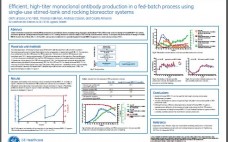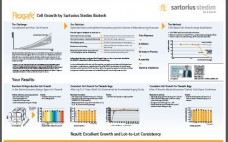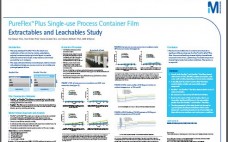For autologous T cell therapy to be effective, T cells sampled from a patient need to be grown in sufficient quantity before being injected back. The typical cell number required for an 80 kg patient is 8.109 cells. Achieving such a dose with T flasks, while maintaining cell health, poses logistical challenges that can become intractable when the number of patients rises. This is why the Xuri™ Cell expansion system W5, a rocking platform which enables automated high cell density…
Year of Publication
Clinically Relevant T Cells Expanded Using the WAVE Bioreactor™ 2/10 System
Lymphocytes, expanded for clinical use, often consist of a small selected starting population, which requires multiple rounds of replication to achieve therapeutic doses. By using perfusion culture with the WAVE Bioreactor 2/10 System, high cell density cultures which are sufficient for therapeutic doses, can be generated. The Cellbag™ bioreactors, used together with the WAVE system, are functionally closed, single-use bioreactors that are delivered pre-sterilized and suitable for cGMP production. Perfusion is automatically maintained by the WAVE system, which removes metabolites…
Efficient High-Titer Monoclonal Antibody Production in a Fed-Batch Process Using Single-Use Stirred-Tank and Rocking Bioreactor Systems
This poster presents a study on the performance of two types of single-use in an antibody fed-batch process. The bioreactors were the stirred tank Xcellerex™ XDR-200 bioreactor and the rocking ReadyToProcess WAVE™ 25 bioreactor system. The cell line used was a CHO-DG44 derived antibody‑producing cell line and the base medium and feeds were from the ActiCHO™ media platform. The results from the parallel cultures presented in figures 3,4 and 5 show that cell growth, productivity and metabolism were very similar.…
In Silico and In Vitro Tools for the Rational Design and Optimization of Novel Vaccines
Subunit vaccines have been shown to have an excellent safety and stability profile compared to the more traditional inactivated or live attenuated vaccines. However, this increased safety is accompanied by the fact that subunit vaccines are often less immunogenic and require adjuvants to induce immunological memory. Comprehensive vaccine design and optimisation approaches can be used to identify the immunogenic parts of the pathogen that contain the B cell and T cell epitopes required for an immune response. Rationally designed vaccines…
New Flexsafe Bag Family: Combining Material Science, Film Expertise and QbD for Reliable and Consistent Cell Growth
The technical and economic benefits of single-use are well known and the bio-manufacturing industry is broadening their adoption in all steps of commercial production. This poster reviews the challenge of poor or inconsistent cell growth associated with the use of single-use bags for media storage and cell culture and how the solutions offered with the new Flexsafe bag family meet these new requirements. The poster introduces a new product development and supply chain management strategy that involves the use of…
PureFlex™ Plus Single-Use Process Container Film Extractables and Leachables Study
Biopharmaceutical companies are using single-use disposable sterile containers and assemblies for upstream and downstream processes at an ever increasing rate, as these specialized technologies and products enable efficient and scalable processes. The newly developed PureFlex™ Plus film contains many of the same ultra low density polyethylene, poly(vinyl acetate) and poly(vinyl alcohol co-ethylene) layers that are in current PureFlex™ film.  The only modification is the outer layer, to provide enhanced mechanical strength, creep resistance and limited permeability to air and gases.…
Design and Manufacture of cGMP, Scalable Expanded Bed Adsorption Chromatography Columns
Expanded Bed Adsorption chromatography (EBA) allows clarification and direct product capture in one unit operation. Upflow conditions achieve a fluidized bed, twice the volume of the settled bed. Crude, high cell density and highly-viscous feed streams such as cell culture, foods and plasma are injected upflow. Cells, cell debris, host cell proteins (HCP’s) and DNA leave the expanded bed, whilst the target molecule is bound to the media. In order to facilitate a renaissance in EBA, columns built to current…
Polishing of Monoclonal Antibodies Using a Polymer Grafted Cation Exchanger
A typical monoclonal antibody purification process begins with a protein A capture step, followed by one or two polishing steps often using ion exchange chromatography media. This poster presents how to use the new cation exchange chromatography medium, Capto™ S ImpAct in MAb polishing. Capto S ImpAct is based on a newly developed grafting technology (Figure 1), resulting in high binding capacity and high resolution. To find the optimal conditions for static binding capacity of a MAb a screening was…
Novel Protein A Chromatography for Single-Use Facilities
Single-use technology has become increasingly popular in both upstream and downstream biopharmaceutical manufacturing. While there has been substantial adoption of upstream single-use technologies, there continues to be a lag in the development and adoption of single-use technologies in downstream – particularly in chromatography. To help achieve the vision of a completely disposable & flexible manufacturing platform, Grace has developed new high capacity pre-packed disposable protein A columns. The new columns integrate the technologies of Grace silica & surface chemistry with…
Automated Quantification of Residual Protein A ligands with Gyrolab™ Protein A Kit
The Gyrolab™ immunoassay platform is well established for automating bioanalytical assays at nanoliter-scale in discovery, pre-clinical, clinical and bioprocess environments. In this presentation, we will show a new kit developed by Gyros using proprietary reagents and technology for the quantification of residual Protein A in bioprocess samples typically from downstream purification. The kit is comprised of labeled anti-Protein A antibodies, buffers for acid dissociation of IgG from Protein A and a Gyrolab mixing CD that automates the acid dissociation and…










